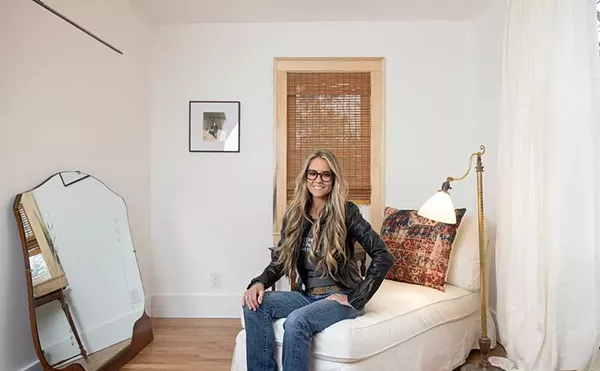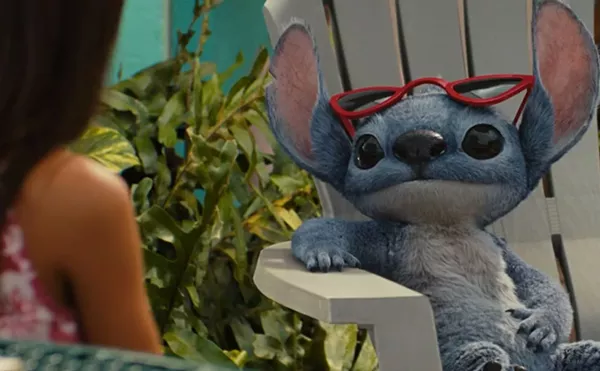
Audio By Carbonatix
[
{
"name": "GPT - Leaderboard - Inline - Content",
"component": "35519556",
"insertPoint": "5th",
"startingPoint": "3",
"requiredCountToDisplay": "3",
"maxInsertions": 100,
"adList": [
{
"adPreset": "LeaderboardInline"
}
]
}
]
Winter Group Exhibition at Lemberg Gallery, Ferndale
At this moment there are at least eight group shows at significant art galleries around metropolitan Detroit. When galleries parade the stable, you know it’s either extremely hot or cold outside because dealers are attempting to attract more people during an otherwise lean time of year. Of course, some galleries just want to show off young or emerging artists who can’t quite support themselves in one-person shows. For whatever purpose these shows serve, this reviewer usually finds them thin and unsatisfying.
But with Winter Group Exhibition, Lemberg Gallery pulls a rabbit out of the hat. They’ve found an equation for a group show that works: Exhibit lots of really fine works of art.
Jane Hammond’s color lithograph /collage “My Heavens!” is a revelation on many levels. Hammond’s personal iconography, consisting of some 276 found or appropriated images, is well-known. This personalized tarot-like imagery appears in sparsely populated paintings, featuring as few as two figures, and in complex paintings that seem more like allegorical I-Ching readings.
In “My Heavens” Hammond’s has replaced the astrological chart of the night sky with this personal set of images and thus in a sense has finally affirmed the primacy of her personal universe. She replaces the whole known language of astrology, and, for that matter, the contemporary night sky of modern astronomy with her own system. “My Heavens” is a beautifully conceived idea and lithograph that effortlessly sums up a lot about her work.
Kiki Smith’s “Las Animas” stands in stark contrast to Hammond’s print. A large collage of black-and-white photogravure images shows intimate details of her own body — a fist, a limp hand, an armpit, a wild, naked crouched pose, the nape of her neck and a veiny ankle. These images invite close scrutiny of her body’s surface, as well as speculation about the relationship between self-representation and identity, who we are and where we reside.
Robert Gniewek’s recent photorealist paintings of Detroit have always suggested intimacy with the city and yet otherworldly loneliness. They are confident views that affirm Gniewek’s knowledge of the city, but they also evoke the uncanny. In the small painting “Mott’s #2” he revisits a previous subject — Detroit’s porcelain hamburger palace. But this time he portrays it like a space station planted in the dark lunar landscape of the city.
Gniewek’s “Woodward Ave., Detroit” presents an early Sunday morning view up a street defined by long shadows of buildings from an eastern sun. Detroit’s classic buildings, the heart of the downtown, are almost diagrammatically depicted. With fragile architectural lines outlining their nominal existence, Detroit looks like it’s disappearing before our eyes. The names of the buildings are absent, as if the city is either a vague memory or a dream of the future. This is photorealism at its philosophically most honest.
One of the real joys of Lemberg’s group exhibition is three small oil paintings by the inimitable James Stephens, a former Detroiter who now lives in Chicago. Each painting is marked by a stunning contrast between a rose-red image and a sickening phosphorescent yellow-green, depicting a landscape of allegorical tension between the evils of industrial culture and the fragility of nature.
Even though there often seems to be a loose, surreal ambiguity in what he depicts, Stephens is always in charge of his imagery. In “Bric A Brac” a brilliant heart-shaped vessel, a bowl containing “cold chisels” (used for cutting steel), an antique hammer and an unraveling ribbon (perhaps a tape measure?) form a miniature landscape, compressed against an intriguing background of geometric and vaporous abstraction.
Lemberg has always stayed in touch with what’s being done by contemporary sculptors. In this show, Tom Phardel and Sharon Que are well represented by new and intriguing hybridized forms, and Sandra Osip’s double-hinged naturalistic forms are contemporary classics. But the best surprise is the work of Lemberg’s own gallery assistant, Rebecca Tufts, whose small porcelain-and-acrylic “Composition 8” hangs quietly in the gallery office and casts, literally, a big shadow. A balanced construction of porcelain objects is suspended in an acrylic armature, which the artist says “suggest function.” It’s nice bit of drawing in space.
Filling out the rest of the exhibit are paintings by Janet Hamrick, Maurice Golubov, Matthew Penkala and Wade Hofer, the watercolors of Darren Waterston and Robert Stackhouse, collage/paintings by Beverly Fishman and a sculpture by Wendy MacGaw. You only get a work or two from each artist, but the work is so uniformly strong you’ll be wandering Lemberg’s winter group show for a long time. — Glen Mannisto
Winter Group Exhibition continues through Feb. 26 at Lemberg Gallery, 23241 Woodward Ave., Ferndale; 248-591-6623. Open 11 a.m.-5 p.m., Wednesday-Saturday.
Bevy at Revolution Gallery, Ferndale
A “bevy” is a group, flock or school. The common phrase “bevy of beauties” occurred to Sandra Schemske as she organized the exhibition of current work by artists at Revolution Gallery. The work is beautiful in the formal and the philosophical senses of the word, fulfilling intense human needs, even awakening deeply hidden yearnings. What’s more, the work’s physical accessibility broaches specific cultural issues.
Several artists featured in Bevy explore the high-low axis in the realms of craft, design and popular culture with an obsessive potency. For them, noisy, personal and over-the-top concepts work well with the beauty of a perfect surface, the precision of execution and a controlled order.
Heather McGill is a master of the genre. For years, she has covered her sculptures of Nike sneaker-sole patterns with layers of spray-painted car enamel, achieving a color density that would make the guys at Monster Garage envious.
This time, McGill’s print on black paper explores the evolution of technology, from the handmade to the laser. Recalling the homey arts-and-crafts snowflakes we made as children, a laser cuts a symmetrical pattern, based on images of an old Chevrolet and its engine parts, that ends up looking like a shoe sole or part of the brain. The form is centered and framed by a mandala-like outline. The print is detailed like a blueprint, but has a fragile physicality; incisions are only visible when light shines through. This isn’t a diagram of how to build a car, but a riff on car design, manufacturing and history.
McGill refuses to accept conservative limitations of gender roles, just as she does any distinction between design and craft or the dismissal of technical mastery. Content agitates refined surface, the banal is bewitched and her inventiveness smothers any possibility of nostalgia. McGill works in unexplored territory where even a small work on paper can be densely beautiful.
Howard Kottler is another such master. His ceramic sculpture “Silver Vase Red Face” plays the figure-ground game: The outline of a silver vase suggests two silhouettes in profile facing each other. Kottler is a pioneer in the pairing of pop culture phenomena with architecture and this piece is both obvious and obscure, comically synthesizing the idea of vase or vessel with a human form to make a hybrid of new identity.
Patrick Burton’s painting on panel “He Loves you So” adapts the candied beauty of a Valentine’s Day card, overloading it to the point where it actually looks fresh, innocent and a bit playful.
Using the simplest of materials — charcoal and conté crayon on paper — Tony Hepburn achieves a profound beauty in his drawing “Retablo.” The work is an altar, a memorial to his recently deceased wife. The image of her hospital bed is backed by a band of white flowers defined by charcoal, like a memory outlined in darkened mist. The iconography shifts from medical to personal. The artist includes three Mexican retablos from Pauline Hepburn’s collection. The materials are tangible, but there is also a strong sense that Tony Hepburn has pinned down what he feels and remembers. In capturing this, his wife is present.
Christian Tedeschi covers a common mirror with tar and feathers, leaving only an eyehole visible. It’s both attractive and repulsive, making a political and social statement about current views on beauty. The formal oval shape, covered in soft white feathers, is sensually compelling. You want to caress it, connect with the mirror as an object of physical illumination and perhaps self-love. But the meaning of tar and feathers is dogged, and the piece brings to mind vanity in a time of brutality and continual human debasement. Should beauty be hidden?
The vintage-looking gelatin silver prints by Debbie Fleming Caffery deal with oppression and the transcendence of spiritual beauty. “Polly,” an old African-American woman from Louisiana, is illuminated amid the darkness of her environment as a gorgeous physical presence, a goddess in old age, unseen but for Fleming Caffery’s lens. The photograph doesn’t tell us of Polly’s poverty or the past that brought her here, just of this pure soul and her ability to know joy. Caffery’s control of tonal composition allows Polly’s gestures and expressions to surface subtly. To know her, she must be discovered through the photographed image.
Other treasures in the show include Brenda Goodman’s “Self-Portrait,” Brian McCutcheon’s “Blue Whale,” David Schutter’s mysterious reworkings of historical still lifes and Ken Fandell’s video, “Complex Imperative.” — Marsha Miro
Runs until Feb. 26, at Revolution, 23257 Woodward Ave., Ferndale; 248-541-3444. Open 11 a.m.-6 p.m., Tuesday-Saturday. Glen Mannisto and Marsha Miro write about art for Metro Times. Send comments to letters@metrotimes.com





